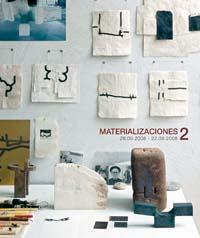Wind steel comb
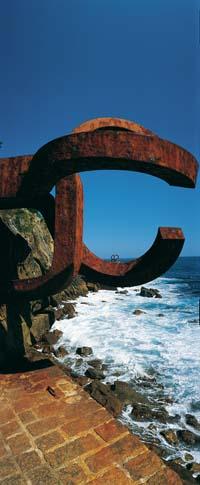
Putting those thirty-three tons in place was not a challenge either. The engineer José María Elosegi took care of this. Chillida requested a helicopter at the American embassy to transport the pieces, but refused. Then, Elosegi built an 80 metre high bridge over the rocks. Through this bridge, Elosegi moved each piece to its place and fixed them well on the rock. Since then there is the Peine del Viento (Wind Comb), which keeps firmly the smoothies and the angry sea.
It seems they were not afraid of the sea. In fact, as if they were waiting for the value that time gives to the works of art, last year the Wind Comb was officially inaugurated. In the framework of the celebration of the 30th anniversary, at the initiative of the Chillida-Leku museum, it was inaugurated without any kind of official act in its day.
And among the activities of this anniversary, technology has been put back to the service of sculpture. During these thirty years Inasmet-Tecnalia has carried out a study on the duration and condition of the pieces of steel of the sculpture. The researcher of this technology center, Ángel María Irisarri, told us the details of this study, which he has collected in the recently published Current State of Conservation of the Wind Comb.

Need for diagnosis
The location of the sculpture is very beautiful, but its conditions are very demanding: the wind, the rain, but especially the influence of the sea, both physical and chemical. In the seasons the sea hits strongly and in the rest is always surrounded by splashes and cresales. And if the humidity is hostile to many materials, let's not say salty humidity. "A common steel would be attacked by salt," says Irisarri.
Therefore, taking into account these conditions and the time elapsed, it was convenient to know the condition of the material in order to apply some suitable remedy in case of danger for sculpture.
Thus, the researchers of Inasmet-Tecnalia began last January to analyze the situation of the sculptural material. The first thing to take into account was the technique that could be used for the diagnosis of sculpture. In fact, "in studies with metals, it is most common to take a sample and analyze it. However, in this case, this sample is destroyed. In the case of the wind comb, of course, we could not destroy the sculpture and for this it was necessary to use a non-destructive technique", explains Mr. Irisarri.
Metallographic replicas
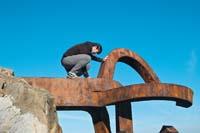
Metallographic replicas allow to detect surface heterogeneity and defects, as well as changes in the microstructure of the material. This technique studies the topography of a surface. To do this it is necessary to place a suitable substance on the surface to be studied, pressing it well, obtaining a surface negative relief. After the microscopic study of this relief, information on fatigue fractures and corrosion damage can be obtained.
The most important limit of this technique is that it only analyzes the surface, so it does not report the internal microstructure of the material. However, most of the corrosion attacks and fatigue fractures occur in the periphery of the piece, so the technique is useful to detect the damage caused by these phenomena. "In the case of the wind comb, the main risk is the corrosion attacks caused by environmental conditions, which, although they can then penetrate the interior, start outside", says Irisarri.
Microstructure in sight

The first step for the application of the metallographic replica technique in the wind comb was the removal of the outer layer of oxide on a small surface to leave the steel in sight. This work was done with great care to cause the least possible damage to the sculpture. The removed oxide was also stored in this process for further laboratory analysis.
Once the steel has been left in sight, the next step was to polish well with lijas and diamond powder. The surface analyzed is 50x30 mm, and after a week they saw again covered with oxide, as well as the rest of the sculpture. "If you don't know where we did it, you won't see it," says Irisarri. Therefore, it can be affirmed that the damage caused to the sculpture is null.
The polishing process is critical and it is essential to do it well, since if irregularities are left, replicas will be collected with precision. And this makes observation very difficult, even erroneous interpretations may be made. Therefore, it is convenient to ensure that this process has been performed properly. For this purpose, after the application and drying of a reagent that highlights the microstructure of the material, a first observation can be made on site using a small microscope. In this way it is valued whether the polishing process and the work done by the reagent are adequate or if it is necessary to perform the process again.
Ensuring that the replica surface was in adequate conditions, the next step was to paste the replica. The replicas are sheets of cellulose acetate. Once the surface of this leaf is dissolved with acetone, it is placed on the surface to be analyzed and waits for the acetone to evaporate. This step is also necessary to be done with great precision, since if when gluing the sheet any small fold would make it very difficult to observe the microstructure. Finally, the sheet is removed and placed on a holder for further observation in the optical and electronic microscope.
At first glance

On the other hand, no blackish spots typical of industrial environments, or yellowish colors caused by sulfur oxides were found. Thus, although the conditions of the location of the sculpture are, on the one hand, hard, it can be said that it is an appropriate place from the point of view of the pollution, since "it would be worse to be in a contaminated environment, since from the oxides of sulfur coming out of the chimneys sulfuric acid is generated, and that yes, yes, it would eat steel", says Irisarri.
But there is no such problem, and in terms of the greatest threat of the area, corrosion, it seems that the sculpture of Chillida bears well. In metallographic replicas it is observed that the microstructure has not undergone modifications. For this it has been essential to compare with a part of the original material that Lenbur kept. This comparison has allowed us to verify that the material is the same as the day of its creation, with a healthy microstructure.
"We were quite convinced that there would be no problems, but in any case we were concerned about what we call stress corrosion," explains Irisarri. It is a corrosion that enters the inside of the material, "it is very dangerous, it is not seen outside and can break the material". But through the replica they have seen that there is no such problem and that the material is in good condition.
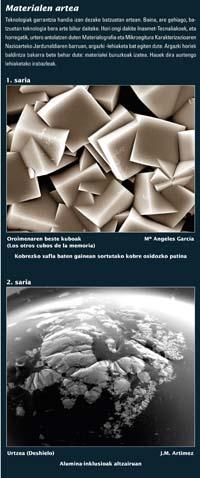
Oxide as protection
The chloride of sea and cresal water is the one that can most damage the steel, but once analyzed the layer of oxide, it is observed that although chloride is abundant in the exterior, it hardly penetrates inside, so it does not affect the material. This oxide layer is the one that protects the material.
The alloy prepared by Patricio Etxeberria contains a lot of phosphorus, copper, nickel and chromium, allowing the formation of continuous and very compact oxide. Iron oxide, for example, perfectly covers all the material, but is porous and fragile and the corrosion that enters through the cracks advances rapidly. In Reco steel, on the other hand, "the oxide layer is not completely waterproof, but it is very difficult to cross," says Irisarri, "so we believe that corrosion will be slower and slower."
"Phosphorus is generally bad for steel, because it makes it more fragile, but it is good to protect it from corrosion, and the most important thing is copper, it is very good to protect it from the marine atmosphere." On the other hand, it is a very low alloy in carbon, which allowed it to give these sinuous forms. Steel with more carbon, such as corten steel, has greater mechanical strength and can only be made plates.
On the other hand, it is important not to be in direct contact with water: "It is wet with sea water, but the rain cleans it and the dry sun, which causes a good layer of rust". If it were constantly impregnated, it would be something else, then corrosion would advance. That's what has happened at the Aloha stadium in Hawaii that you now have to solve. The steel has deteriorated in a permanently wet zone. The wet drying cycle is very important to achieve good protection of rust.
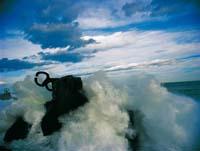
Irisarri has no doubts: "The material was very well selected." On the one hand, the composition is adequate to adopt the shapes required by the sculpture and, at the same time, to protect itself from corrosion. But, in addition, the reddish color that gives the rust comes well with the medium. "Stainless steel would also have been a good option from the point of view of conservation, but its metallic tone would not have coincided with the landscape." And it goes further, "for the importance that iron has had in the history of Euskal Herria, it is a well selected material".
In the words of Chillida, in addition to the wind he admires and the tribute to San Sebastián, the Peine del Viento is a question of the future. And the researcher of Inasmet-Tecnalia has also dared to talk about the future: "If there is no tsunami, the sculpture will last long." It seems, therefore, that from now on, and for many years, the steel comb of the wind will resist without problems the attacks of the sea and the salinity of the crest.
